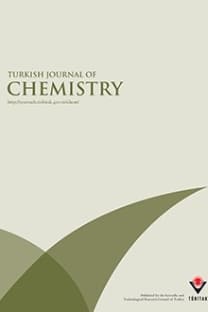Graphene oxide--magnetite nanocomposite as an efficient and magnetically separable adsorbent for methylene blue removal from aqueous solution
Graphene oxide, Fe3O4 nanoparticles, composite sorbent, magnetic separation, dye removal, methylene blue
Graphene oxide--magnetite nanocomposite as an efficient and magnetically separable adsorbent for methylene blue removal from aqueous solution
Graphene oxide, Fe3O4 nanoparticles, composite sorbent, magnetic separation, dye removal, methylene blue,
___
- [this work] [27] [28] [29] [30]
- Figure 4. (A) TEM image of the GO–Fe3O4hybrid composite after adsorption of MB, (B) the reusability of the GO–Fe3O4composite in the MB removal from aqueous solution for 5 successive runs. ([GO–Fe3O4] = 0.6 g/L and [MB] = 13 mg/L).
- Experimental section 3.1. Materials
- Iron(III) acetylacetonate (Fe(acac)3,≥99.9%), oleylamine (OAm, >70%), benzyl ether (BE, 98%) potassium permanganate (KMnO4,
- ≥9%), potassium peroxodisulfate (K2S2O8,≥99.9%), phosphorous pentaoxide (P2O5,≥98%), hydrogen peroxide (H
- , 30%), sodium nitrate (NaNO3,≥99.9%), sulfuric acid (H2SO, 98%), N,N-dimethylformamide (DMF, 99.8%), and methylene blue (MB) were purchased from Sigma-Aldrich. Natural graphite flakes (average particle size 325 mesh) were purchased from Alfa Aesar. All chemicals were used without any further purification. Deionized water was distilled by water purification system (Milli-Q System).
- Characterization
- Synthesis of GO–Fe3O4nanocomposite
- The dye adsorption experiments were carried out in round bottom flasks at room temperature. In a typical experiment, 25 mL of aqueous solution of MB with a known initial concentration was mixed with 25 mg of the GO–Fe3O4nanocomposite well-dispersed in water via sonication. The resultant mixture was shaken for 24 h at pH
- ∼ Next, the GO–Fe3O4
- (1) where qe is the concentration of dye adsorbed (mg/g), Coand Ceare the initial and equilibrium concentrations of dye (mg/L), m is the mass of the GO–FeO4(g), and V is the volume of solution (L).11,17The adsorption experiment was also performed at different pH values by adjusting pH via use of HCl and NaOH. References
- ISSN: 1300-0527
- Yayın Aralığı: 6
- Yayıncı: TÜBİTAK
Yasmeen JUNEJO, Abdulhadi BAYKAL
Yaşar DÜRÜST, Hamza KARAKUŞ, Muhsine Zeynep YAVUZ, Ali Akçahan GEPDİREMEN
Mohammad Shakhawoat HOSSAIN, Sıdıka POLAT ÇAKIR\dag, Ayşe Betül KARADUMAN
Gülden Başmakçi AKYIL, Hayriye Eda Şatana KARA, Sezen Yarimkaya BAŞ, Nusret ERTAŞ, Nilgün GÜNDEN GÖĞER
Leyla YURTTAŞ, Yusuf ÖZKAY, Fatih DEMİRCİ, Gamze GÖGER, Şafak Ulusoylar YILDIRIM, Usama ABU MOHSEN, Ömer ÖZTÜRK, Zafer Asım KAPLANCIKLI
Linear assembly and 3D networks of peptide modified gold nanoparticles
Şaban KALAY, Clement BLANCHET, Mustafa CULHA
QSAR study of chalcone derivatives as anti-Leishmania agents
Maryam IMAN, Asghar DAVOOD, Nasimossadat BANAROUEI
Green synthesis of Fe3O4 nanoparticles by one-pot saccharide-assisted hydrothermal method
Ayşe DEMİR, Abdulhadi BAYKAL, Hüseyin SÖZERİ
Calixcephems: clustered cephalosporins analogous to calixpenams as novel potential anti-MRSA agents
